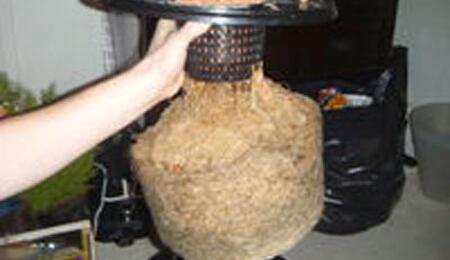Hydro Head-To-Head, PartII

If you are sick of soil growing, try NFT, DWC or aeroponics
If you are sick of soil growing, try NFT, DWC or aeroponics
In Part I, we had a look at the pros and cons of flood-and-drain, passive hydroponics and drip irrigation, plus how they compare to hand feeding. In Part II, we will discuss the pros and cons of deep water culture (DWC), nutrient film technique (NFT) and aeroponic Cannabis growing systems.|
An awesome DWC rootball |
DWC: What Is It?
Deep water culture or DWC is a growing method whereby the roots of the plant are constantly submerged in a highly-oxygenated nutrient solution - hence the term 'deep water.' Very little growing medium is used, other than a propagation cube and a few clay pebbles. The initial root ball of the plant is started in a net pot, suspended above a reservoir or bucket. The roots of the plant grow out of the pot and into the reservoir, where there is constant availability of water, nutrient and oxygen, delivered via an air pump. Plants that are grown in DWC setups receive a huge supply of nutrient solution and oxygen. When executed correctly, amazing results are possible. DWC Pros Simplest hydro system: Most systems are just a bucket, a net pot and an air pump. There are no moving parts and no external pipework, thus no possibility of leaks. Turbo-charged yields: DWC systems offer massive exposure of the plants' roots to water, nutrients and oxygen. They literally sit in a bath of heavily-oxygenated food! Big yields, here we come! No feeding schedules to work out: Plant roots have constant exposure to all of the water and nutrient they require. They uptake whatever they need, exactly when they need it, so there is no need for a timer. DWC Cons Noisy: Any system powered by an air pump will create a buzzing sound. One system on its own is okay, but put four in your tent and it will drive you crazy! Try hanging them on an elastic bungee cord to cut down on the vibrations. Cleaning the reservoir: To perform cleaning duties, lift the lid and plant off of the system and transfer it onto a second bucket. Sound easy? Try doing it with a five-foot plant covered in bud and a root ball that does not want to fit back into the bucket - that is a two-man job.|
Hobby-sized NFT system with some nice personal smoke |
NFT: What Is It?
NFT stands for nutrient film technique, and is a system where nutrient solution is pumped onto a tray or, in commercial situations, a gulley in order to create a very shallow, slow-moving film that flows through the roots of the plants, providing them with all of the elements that they need. The roots of the plants grow into the solution and fill the tray or gulley, forming a large root mat. This constant access to water and nutrients, combined with an abundant supply of oxygen to the roots, means that plants grown in NFT setups develop very rapidly and produce significantly larger yields than soil-grown plants. This is why it is a preferred method in commercial horticulture for quick-cropping plants like lettuce and herbs. NFT Pros Faster growth rates and bigger yields: Because plants have constant access to what they need, they grow faster and yield more. The accelerated growth rates shorten the veg cycle, so you get more crops per year and, when dialed-in correctly, you can harvest significantly higher yields than with conventional compost growing. It is simple: As hydro systems go, NFT is extremely easy to set up. There are no complicated delivery systems or feeding schedules to calculate. Plus, because the system is always ‘on' and plants just take what they need, there is no chance of over- or underfeeding. Clean to use and produces minimum waste: No compost means that there is no chance of soil-borne pests and no heavy bags of medium to carry around when setting up or after chopping down. Just roll up the root mat and throw it away! NFT Cons Root disease: Talk to any seasoned grower about NFT and they will all tell you the same thing: we get fantastic results, BUT watch out for Pythium! As the roots of the plants are constantly bathed in water, it is easy for root disease to take hold. High temperatures can bring on an attack within a matter of hours. Use a heater or air conditioner to maintain a steady root temp of 68º F to 72º F, and apply root treatments (e.g., PYTH Tabz or Regen-A-Root) at the first sign of trouble. Constant monitoring: The constant access to the nutrient solution allows the roots to constantly feed. As they feed, the balance of nutrients in the solution changes and the EC fluctuates. You need to be on your game with monitoring EC - and pH for that matter - otherwise, your plants will suffer deficiencies. For best results, change the solution a minimum of once per week, or more often as the plants are flowering. Toppling plants: NFT provides no support to the plant structure, so, once plants begin to flower, they become top-heavy and topple over. Plan your supports before the flowering stage and have your pea netting and yoyos at the ready.|
Roots in an aeroponic cloner |
Aeroponics: What Is It?
Aeroponics is a growing method whereby the roots of a plant are suspended in air and constantly sprayed with a mist of nutrient solution. No growing medium is used, other than a propagation cube if the plant was started from seed. The roots of the plant grow into a chamber or channel where they are fed by misters, sprinklers or spray heads that deliver the nutrient solution via a pump. Aeroponics can be used to grow plants throughout each stage of their life cycle and also produces excellent results when used to propagate clones. Plants that are grown aeroponically have constant access to nutrient solution and oxygen, thereby taking up much more water and nutrients than plants that are hand-watered. The more oxygen, water and nutrients that a plant can absorb, the bigger the yields that they will produce. Aeroponics Pros Ultimate speed of growth and massive yields: Of all of the systems on the market, aeroponic systems offer the maximum possible exposure of plant roots to water, nutrients and oxygen. The more availability of these three key elements that the plant has, the faster it will develop and, ultimately, the more bud it will yield. Faster turnaround of clones: Aeroponic cloners are the fastest way to root a cutting. Transplanting within five to six days is not unheard of and some of the larger cloners fit over a hundred cuttings! Healthy root zone: No growing medium whatsoever is required, not even a propagation cube. This leads to a reduced risk of soil-borne pests and diseases. Aeroponics Cons High performance, high risk: Aeroponic growing, done right, is pretty much the pinnacle of plant performance. The yields achievable are stupendous! However, running an aeroponic system is a bit like driving a Ferrari full contraband down the road - amazing performance, but one small mistake and you are fucked! The lack of growing media around the roots means that the plants are highly susceptible to overfeeding, temperature, pH fluctuations and root disease. While the systems themselves need a lot of maintaining, a freak power failure knocks your pump off or a sprinkler stops working and your plants are dead within hours. However, for the smaller-scale hobby grower, the take is worth the risk! Happy growing!
S
Soft Secrets



